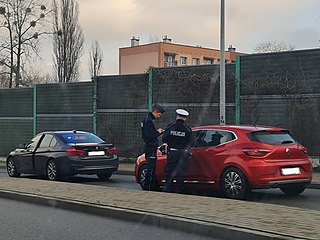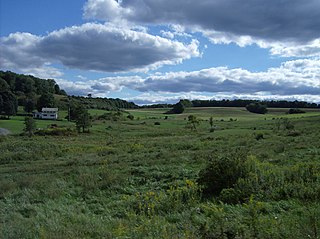Hiibel v. Sixth Judicial District Court of Nevada, 542 U.S. 177 (2004), is a United States Supreme Court case in which the Court held that a statute requiring suspects to disclose their names during a valid Terry stop does not violate the Fourth Amendment if the statute first requires reasonable suspicion of criminal involvement, and does not violate the Fifth Amendment if there is no allegation that their names could have caused an incrimination.
Terry v. Ohio, 392 U.S. 1 (1968), was a landmark U.S. Supreme Court decision in which the court ruled that it is constitutional for American police to "stop and frisk" a person they reasonably suspect to be armed and involved in a crime. Specifically, the decision held that a police officer does not violate the Fourth Amendment to the U.S. Constitution's prohibition on unreasonable searches and seizures when questioning someone even though the officer lacks probable cause to arrest the person, so long as the police officer has a reasonable suspicion that the person has committed, is committing, or is about to commit a crime. The court also ruled that the police officer may perform a quick surface search of the person's outer clothing for weapons if they have reasonable suspicion that the person stopped is "armed and presently dangerous." This reasonable suspicion must be based on "specific and articulable facts," and not merely upon an officer's hunch.
New Jersey v. T. L. O., 469 U.S. 325 (1985), is a landmark decision by the Supreme Court of the United States which established the standards by which a public school official can search a student in a school environment without a search warrant, and to what extent.
A Terry stop in the United States allows the police to briefly detain a person based on reasonable suspicion of involvement in criminal activity. Reasonable suspicion is a lower standard than probable cause which is needed for arrest. When police stop and search a pedestrian, this is commonly known as a stop and frisk. When police stop an automobile, this is known as a traffic stop. If the police stop a motor vehicle on minor infringements in order to investigate other suspected criminal activity, this is known as a pretextual stop. Additional rules apply to stops that occur on a bus.

A traffic stop, commonly referred to as being pulled over, is a temporary detention of a driver of a vehicle and its occupants by police to investigate a possible crime or minor violation of law.
United States v. Place, 462 U.S. 696 (1983), is a decision by the Supreme Court of the United States in which the Court held that it does not violate the Fourth Amendment to the U.S. Constitution for a trained police dog to sniff of a person's luggage or property in a public place.

The open-fields doctrine, in the U.S. law of criminal procedure, is the legal doctrine that a "warrantless search of the area outside a property owner's curtilage" does not violate the Fourth Amendment to the United States Constitution. However, "unless there is some other legal basis for the search," such a search "must exclude the home and any adjoining land that is within an enclosure or otherwise protected from public scrutiny."
Reasonable suspicion is a legal standard of proof in United States law that is less than probable cause, the legal standard for arrests and warrants, but more than an "inchoate and unparticularized suspicion or 'hunch'"; it must be based on "specific and articulable facts", "taken together with rational inferences from those facts", and the suspicion must be associated with the specific individual. If police additionally have reasonable suspicion that a person so detained is armed and dangerous, they may "frisk" the person for weapons, but not for contraband like drugs. However, if the police develop probable cause during a weapons frisk, they may then conduct a full search. Reasonable suspicion is evaluated using the "reasonable person" or "reasonable officer" standard, in which said person in the same circumstances could reasonably suspect a person has been, is, or is about to be engaged in criminal activity; it depends upon the totality of circumstances, and can result from a combination of particular facts, even if each is individually innocuous.
Florida v. Riley, 488 U.S. 445 (1989), was a United States Supreme Court decision which held that police officials do not need a warrant to observe an individual's property from public airspace.

"Stop and identify" statutes are laws in several U.S. states that authorize police to lawfully order people whom they reasonably suspect of a crime to state their name. If there is not reasonable suspicion that a crime has been committed, is being committed, or is about to be committed, an individual is not required to identify themselves, even in these states.
United States v. Montoya De Hernandez, 473 U.S. 531 (1985), was a U.S. Supreme Court case regarding the Fourth Amendment's border search exception and balloon swallowing.
Illinois v. Caballes, 543 U.S. 405 (2005), is a decision by the Supreme Court of the United States in which the Court held that the use of a drug-sniffing police dog during a routine traffic stop does not violate the Fourth Amendment to the U.S. Constitution, even if the initial infraction is unrelated to drug offenses.
Whren v. United States, 517 U.S. 806 (1996), was a unanimous United States Supreme Court decision that "declared that any traffic offense committed by a driver was a legitimate legal basis for a stop."
Immigration and Naturalization Service v. Delgado, 466 U.S. 210 (1984), was a United States Supreme Court decision on the limits of worksite enforcement by immigration agents. Specifically, the Court ruled that factory raids by the Immigration and Naturalization Service (INS) were not illegal seizures under the Fourth Amendment to the U.S. Constitution.
Pennsylvania v. Mimms, 434 U.S. 106 (1977), is a United States Supreme Court criminal law decision holding that a police officer ordering a person out of a car following a traffic stop and conducting a pat-down to check for weapons did not violate the Fourth Amendment to the United States Constitution.
United States v. Mendenhall, 446 U.S. 544 (1980), was a United States Supreme Court case that determined "seizure" occurs when an officer uses displays of authority to detain a person.
Rodriguez v. United States, 575 U.S. 348 (2015), was a United States Supreme Court case which analyzed whether police officers may extend the length of a traffic stop to conduct a search with a trained detection dog. In a 6–3 opinion, the Court held that officers may not extend the length of a traffic stop to conduct a dog sniff unrelated to the original purpose of the stop. However, the Court remanded the case to the United States Court of Appeals for the Eighth Circuit to determine whether the officer's extension of the traffic stop was independently justified by reasonable suspicion. Some analysts have suggested that the Court's decision to limit police authority was influenced by ongoing protests in Ferguson, Missouri.
Navarette v. California, 572 U.S. 393 (2014), was a case in which the United States Supreme Court clarified when police officers may make arrests or conduct temporary detentions based on information provided by anonymous tips. In 2008, police in California received a 911 call that a pickup truck was driving recklessly along a rural highway. Officers spotted a truck matching the description provided in the 911 call and followed the truck for five minutes, but did not observe any suspicious behavior. Nevertheless, officers conducted a traffic stop and discovered 30 pounds (14 kg) of marijuana in the truck. At trial, the occupants of the car argued that the traffic stop violated the Fourth Amendment of the United States Constitution, because the tip was unreliable, and officers did not personally observe criminal activity. Writing for a majority of the Court, Justice Clarence Thomas held that the 911 call was reliable, and that officers need not personally observe criminal activity when acting upon information provided by an anonymous 911 call.
Kansas v. Glover, 589 U.S. ___ (2020), was a United States Supreme Court case in which the Court held when a police officer lacks information negating an inference that the owner is driving a vehicle, an investigative traffic stop made after running a vehicle's license plate and learning that the registered owner's driver's license has been revoked is reasonable under the Fourth Amendment.
United States v. Cortez, 449 U.S. 411 (1981), was a United States Supreme Court decision clarifying the reasonable suspicion standard for the investigative stop of a vehicle.



